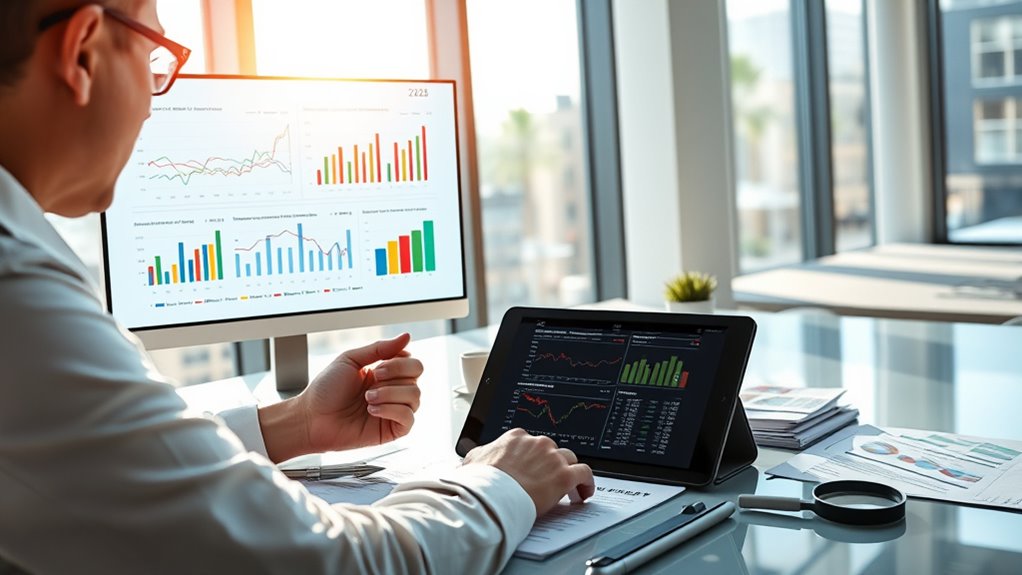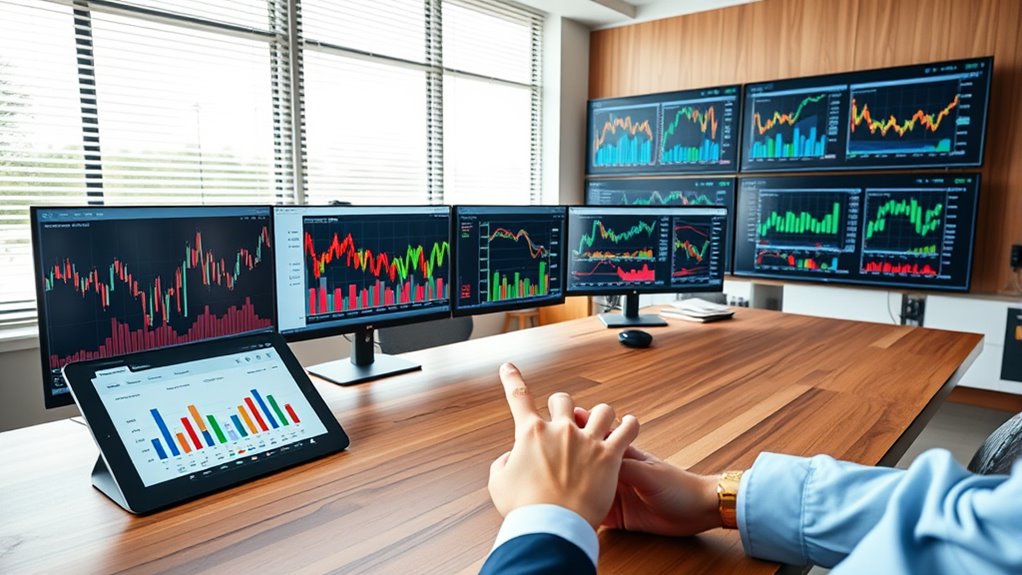To evaluate and compare ETFs in 2025, focus on their underlying assets, sector coverage, and risk profile to match your investment goals. Check expense ratios and transaction costs to find cost-effective options. Understand whether the ETF is actively managed or passive, and review liquidity to ensure easy trading. Stay aware of market conditions and regularly review each ETF’s strategy and holdings. If you explore further, you’ll gain the insights needed to make informed decisions.
Key Takeaways
- Assess ETF risk profile by examining underlying assets, sector coverage, historical performance, and alignment with your investment horizon.
- Compare expense ratios and additional costs like bid-ask spreads to identify cost-efficient options.
- Determine if the ETF is passive or active, ensuring its strategy matches your risk tolerance and long-term goals.
- Evaluate liquidity through trading volume and bid-ask spreads for ease of trading and minimal transaction costs.
- Stay informed on current market conditions and regularly review ETF holdings, fees, and strategy adjustments for ongoing suitability.

As the ETF market continues to evolve in 2025, understanding how to evaluate and compare these investment options becomes more essential than ever. With hundreds of ETFs available, you need a clear strategy to identify which ones align with your financial goals. Start by conducting a thorough risk assessment. Consider the ETF’s underlying assets and the sector it covers. If you’re risk-averse, you might prefer ETFs that track broad, stable markets like large-cap equities or bonds. Conversely, if you’re comfortable with higher volatility, sector-specific or emerging market ETFs could offer greater growth potential. Look into the fund’s historical performance, but remember that past results don’t guarantee future returns. Instead, focus on how the ETF’s risk profile matches your investment horizon and risk tolerance.
Next, perform a detailed fee analysis. Fees can markedly impact your long-term returns, so don’t overlook them. Examine the expense ratio, which covers management fees and operational costs. A lower expense ratio often indicates a more cost-efficient fund, but be cautious of extremely low fees that may come with trade-offs in liquidity or tracking accuracy. Look into additional costs such as bid-ask spreads and commissions, especially if you plan to trade frequently. These hidden costs can eat into your profits over time. Comparing fees across similar ETFs helps you identify the most cost-effective options without sacrificing quality or diversification. It’s also important to consider the market environment, which can influence ETF performance and trading costs.
Perform a thorough fee analysis, including expense ratios and trading costs, to maximize long-term investment returns.
In addition to risk and fees, assess the ETF’s structure and strategy. Check whether it’s actively managed or passively tracking an index. Passive ETFs typically have lower fees and more predictable performance, making them suitable for long-term buy-and-hold strategies. Active funds might aim to outperform the market but often come with higher fees and increased risk. Review the fund’s holdings and see if they match your investment preferences. Diversification is key—avoiding concentration in a single sector or asset class helps manage risk. Also, consider liquidity by examining the trading volume; more liquid ETFs are easier to buy and sell without impacting the price considerably.
Finally, stay current with market conditions and any changes within the ETF itself. Fund providers can adjust strategies, holdings, or fees, so regular reviews are essential. Comparing ETFs isn’t just about looking at numbers; it’s about understanding how each fund fits into your overall investment plan. By evaluating risk levels, analyzing fees, and considering the fund’s structure and liquidity, you can make more informed choices that support your financial growth in 2025.
Frequently Asked Questions
How Do Geopolitical Events Impact ETF Performance in 2025?
Geopolitical risks profoundly impact ETF performance in 2025 by creating market instability and uncertainty. When tensions rise or conflicts occur, investors tend to withdraw from risky assets, leading to declines in ETFs tied to affected regions or sectors. Conversely, some ETFs may benefit if they hedge against geopolitical risks. Keep a close eye on global events, as they directly influence market stability and your investment outcomes.
What Role Will AI Play in ETF Management Strategies?
AI integration will revolutionize ETF management strategies by enabling robo advisors to analyze vast data sets quickly, identify trends, and optimize portfolios in real time. You’ll benefit from more personalized, efficient investment advice, with AI-driven tools helping you make smarter decisions. As AI becomes more sophisticated, expect ETFs to incorporate dynamic strategies that adapt to market changes swiftly, giving you greater control and better potential returns in your investments.
Are ESG ETFS More Volatile Than Traditional ETFS?
They say, “Don’t put all your eggs in one basket,” and that’s true for ESG ETFs. They can be more volatile than traditional ETFs because ESG risks, like regulatory changes or reputation issues, can impact their value. To assess this, you should compare valuation metrics and understand how ESG factors influence market performance. Keep in mind, higher potential gains often come with increased risk.
How Do Currency Fluctuations Affect International ETFS?
Currency fluctuations impact international ETFs through currency risks, which can cause your investment returns to vary based on exchange rate movements. When the local currency weakens against your home currency, your ETF’s value may decline, even if the underlying assets perform well. To manage this, you can consider hedging strategies, such as currency forwards or options, to protect against adverse exchange rate shifts and reduce your exposure to currency risks.
What Emerging Sectors Should Investors Consider in 2025?
Think of 2025 as a garden bursting with new blooms. You should consider investing in renewable energy, which is like planting seeds for a sustainable future, and biotech innovation, the vibrant flowers transforming healthcare. These sectors are emerging fast, offering growth opportunities. Keep an eye on government policies and technological advances, as they’ll help you navigate this dynamic landscape and maximize your investments in these promising areas.
Conclusion
Think of evaluating ETFs like tending a garden—you need to check the soil, sunlight, and water to guarantee healthy growth. By analyzing fees, performance, and holdings, you’re nurturing your investment landscape. Comparing options helps you weed out the weeds and focus on the best plants to thrive. Stay attentive and adaptable, and your portfolio will flourish like a well-tended garden, yielding fruitful returns in 2025 and beyond.









